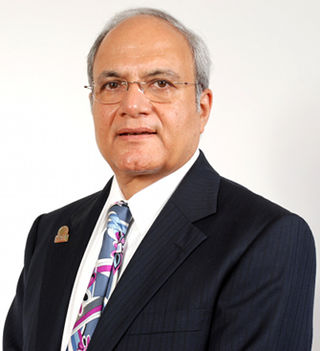
An integrated circuit, also known as a microchip or IC, is a small electronic device made up of multiple interconnected electronic components such as transistors, resistors, and capacitors. These components are etched onto a small piece of semiconductor material, usually silicon. Integrated circuits are used in a wide range of electronic devices, including computers, smartphones, and televisions, to perform various functions such as processing and storing information. They have greatly impacted the field of electronics by enabling device miniaturization and enhanced functionality.

The Indian Institute of Technology Bombay is a public research university and technical institute in Powai, Mumbai, Maharashtra, India.

Taiwan Semiconductor Manufacturing Company Limited is a Taiwanese multinational semiconductor contract manufacturing and design company. It is the world's second most valuable semiconductor company, the world's largest dedicated independent ("pure-play") semiconductor foundry, and its country's largest company, with headquarters and main operations located in the Hsinchu Science Park in Hsinchu, Taiwan. It is majority owned by foreign investors, and the central government of Taiwan is the largest shareholder.
The semiconductor industry is the aggregate of companies engaged in the design and fabrication of semiconductors and semiconductor devices, such as transistors and integrated circuits. It formed around 1960, once the fabrication of semiconductor devices became a viable business. The industry's annual semiconductor sales revenue has since grown to over $481 billion, as of 2018.

The Centro Nacional de Tecnologia Electrônica Avançada S.A is a Brazilian technology center specialized in project development and fabrication in microelectronics, i.e. integrated circuits, or "chips". This center is one of the agents for the Brazilian Microelectronics Program.

The X-FAB Silicon Foundries is a group of semiconductor foundries. The group specializes in the fabrication of analog and mixed-signal integrated circuits for fabless semiconductor companies, as well as MEMS and solutions for high voltage applications. The holding company named "X-FAB Silicon Foundries SE" is based in Tessenderlo, Belgium while its headquarters is located in Erfurt, Germany.
Bharat Electronics Limited (BEL) is an Indian Government-owned aerospace and defence electronics company. It primarily manufactures advanced electronic products for ground and aerospace applications. BEL is one of sixteen PSUs under the Ministry of Defence of India. It has been granted Navratna status by the Government of India.
The term die shrink refers to the scaling of metal–oxide–semiconductor (MOS) devices. The act of shrinking a die creates a somewhat identical circuit using a more advanced fabrication process, usually involving an advance of lithographic nodes. This reduces overall costs for a chip company, as the absence of major architectural changes to the processor lowers research and development costs while at the same time allowing more processor dies to be manufactured on the same piece of silicon wafer, resulting in less cost per product sold.

Indian Institute of Technology Patna is a public research university and technical institute located at Bihta near Patna, Bihar. It is recognized as an Institute of National Importance by the Government of India. It is one of the second generation IITs established by an Act of the Indian Parliament on August 6, 2008.
GlobalFoundries Inc. (GF) is a multinational semiconductor contract manufacturing and design company incorporated in the Cayman Islands and headquartered in Malta, New York. Created by the divestiture of the manufacturing arm of AMD, the company was privately owned by Mubadala Investment Company, a sovereign wealth fund of the United Arab Emirates, until an initial public offering (IPO) in October 2021.

pSemi, is a San Diego-based manufacturer of high-performance RF CMOS integrated circuits. A Murata Manufacturing company since December 2014, the company's products are used in aerospace and defense, broadband, industrial, mobile wireless device, test and measurement equipment and wireless infrastructure markets. Their UltraCMOS technology is a proprietary implementation of silicon on sapphire (SOS) and silicon on insulator (SOI) substrates that enables high levels of monolithic integration.

Ajai Chowdhry is one of the six founding members of HCL. He is currently the Chairman-Board of Governors at National Institute of Foundry and Forge Technology (NIFFT), Ranchi, International Institute of Information Technology, and Naya Raipur.
The IEEE International Electron Devices Meeting (IEDM) is an annual micro- and nanoelectronics conference held each December that serves as a forum for reporting technological breakthroughs in the areas of semiconductor and related device technologies, design, manufacturing, physics, modeling and circuit-device interaction.

The Ministry of Electronics and Information Technology (MEITy) is an executive agency of the Union Government of the Republic of India. It was carved out of the Ministry of Communications and Information Technology on 19 July 2016 as a standalone ministerial agency responsible for IT policy, strategy and development of the electronics industry. Under the sponsorship of the Ministry of Electronics and Information Technology, the "Northeast Heritage" Web, owned by the Government of India, publishes information on Northeast India, in 5 Indian languages, Assamese, Meitei (Manipuri), Bodo, Khasi and Mizo, in addition to Hindi and English.
Venu Ramgopal Rao is an Indian academic currently serving as the Group Vice Chancellor of Birla Institute of Technology and Science, Pilani for campuses located in Pilani, Dubai, Goa, Hyderabad and Mumbai. He was previously the Director of IIT, Delhi for six years during 2016-2021.

Kunnath Puthiyaveettil Padmanabhan Nambiar DIC (Lond), FIEE (Lond), CEngg (Lond.), more popularly known as K.P.P. Nambiar, was an Indian industrialist and technocrat, known for his work in the field of industrial development and technology. He was awarded Padma Bhushan by Government of India for his contributions to the field of technology in 2006.
Early in the twenty-first century, foreign investment as well as government regulations and incentives promoted growth in the Indian electronics industry. The semiconductor industry, which is its most important and resource-intensive sector, profited from the rapid growth in domestic demand. Many industries, including telecommunications, information technology, automotive, engineering, medical electronics, electricity and solar photovoltaic, defense and aerospace, consumer electronics, and appliances, required semiconductors. However, as of 2015, progress was threatened by the talent gap in the Indian sector, since 65 to 70 percent of the market was dependent on imports.

Dr. Gary Patton is an American technologist and business executive. He is currently the Corporate Vice President and General Manager of Design Enablement and Components Research in the Technology Development Group at Intel. He has spent most of his career in IBM, starting in IBM's Research Division and holding management and executive positions in IBM's Microelectronics Division in Technology Development, Design Enablement, Manufacturing, and Business Line Management.

The CHIPS and Science Act is a U.S. federal statute enacted by the 117th United States Congress and signed into law by President Joe Biden on August 9, 2022. The act authorizes roughly $280 billion in new funding to boost domestic research and manufacturing of semiconductors in the United States, for which it appropriates $52.7 billion. The act includes $39 billion in subsidies for chip manufacturing on U.S. soil along with 25% investment tax credits for costs of manufacturing equipment, and $13 billion for semiconductor research and workforce training, with the dual aim of strengthening American supply chain resilience and countering China. It also invests $174 billion in the overall ecosystem of public sector research in science and technology, including in NASA, the DOE, and NIST.











